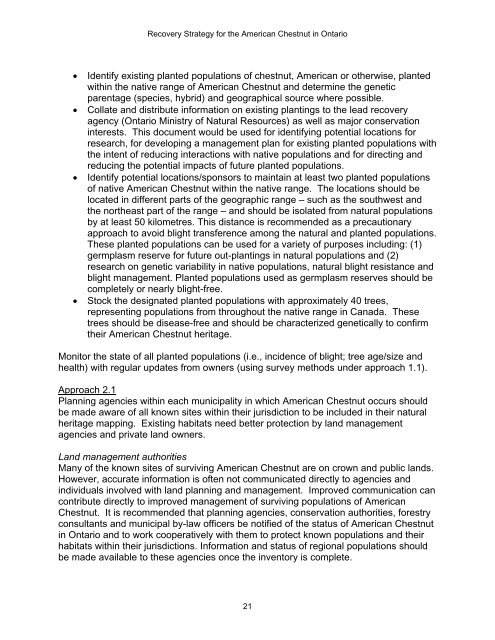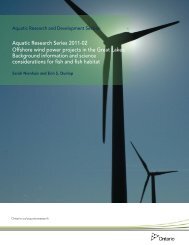(Castanea dentata) in Ontario - Ministry of Natural Resources ...
(Castanea dentata) in Ontario - Ministry of Natural Resources ...
(Castanea dentata) in Ontario - Ministry of Natural Resources ...
Create successful ePaper yourself
Turn your PDF publications into a flip-book with our unique Google optimized e-Paper software.
Recovery Strategy for the American Chestnut <strong>in</strong> <strong>Ontario</strong><br />
<br />
<br />
<br />
<br />
Identify exist<strong>in</strong>g planted populations <strong>of</strong> chestnut, American or otherwise, planted<br />
with<strong>in</strong> the native range <strong>of</strong> American Chestnut and determ<strong>in</strong>e the genetic<br />
parentage (species, hybrid) and geographical source where possible.<br />
Collate and distribute <strong>in</strong>formation on exist<strong>in</strong>g plant<strong>in</strong>gs to the lead recovery<br />
agency (<strong>Ontario</strong> M<strong>in</strong>istry <strong>of</strong> <strong>Natural</strong> <strong>Resources</strong>) as well as major conservation<br />
<strong>in</strong>terests. This document would be used for identify<strong>in</strong>g potential locations for<br />
research, for develop<strong>in</strong>g a management plan for exist<strong>in</strong>g planted populations with<br />
the <strong>in</strong>tent <strong>of</strong> reduc<strong>in</strong>g <strong>in</strong>teractions with native populations and for direct<strong>in</strong>g and<br />
reduc<strong>in</strong>g the potential impacts <strong>of</strong> future planted populations.<br />
Identify potential locations/sponsors to ma<strong>in</strong>ta<strong>in</strong> at least two planted populations<br />
<strong>of</strong> native American Chestnut with<strong>in</strong> the native range. The locations should be<br />
located <strong>in</strong> different parts <strong>of</strong> the geographic range – such as the southwest and<br />
the northeast part <strong>of</strong> the range – and should be isolated from natural populations<br />
by at least 50 kilometres. This distance is recommended as a precautionary<br />
approach to avoid blight transference among the natural and planted populations.<br />
These planted populations can be used for a variety <strong>of</strong> purposes <strong>in</strong>clud<strong>in</strong>g: (1)<br />
germplasm reserve for future out-plant<strong>in</strong>gs <strong>in</strong> natural populations and (2)<br />
research on genetic variability <strong>in</strong> native populations, natural blight resistance and<br />
blight management. Planted populations used as germplasm reserves should be<br />
completely or nearly blight-free.<br />
Stock the designated planted populations with approximately 40 trees,<br />
represent<strong>in</strong>g populations from throughout the native range <strong>in</strong> Canada. These<br />
trees should be disease-free and should be characterized genetically to confirm<br />
their American Chestnut heritage.<br />
Monitor the state <strong>of</strong> all planted populations (i.e., <strong>in</strong>cidence <strong>of</strong> blight; tree age/size and<br />
health) with regular updates from owners (us<strong>in</strong>g survey methods under approach 1.1).<br />
Approach 2.1<br />
Plann<strong>in</strong>g agencies with<strong>in</strong> each municipality <strong>in</strong> which American Chestnut occurs should<br />
be made aware <strong>of</strong> all known sites with<strong>in</strong> their jurisdiction to be <strong>in</strong>cluded <strong>in</strong> their natural<br />
heritage mapp<strong>in</strong>g. Exist<strong>in</strong>g habitats need better protection by land management<br />
agencies and private land owners.<br />
Land management authorities<br />
Many <strong>of</strong> the known sites <strong>of</strong> surviv<strong>in</strong>g American Chestnut are on crown and public lands.<br />
However, accurate <strong>in</strong>formation is <strong>of</strong>ten not communicated directly to agencies and<br />
<strong>in</strong>dividuals <strong>in</strong>volved with land plann<strong>in</strong>g and management. Improved communication can<br />
contribute directly to improved management <strong>of</strong> surviv<strong>in</strong>g populations <strong>of</strong> American<br />
Chestnut. It is recommended that plann<strong>in</strong>g agencies, conservation authorities, forestry<br />
consultants and municipal by-law <strong>of</strong>ficers be notified <strong>of</strong> the status <strong>of</strong> American Chestnut<br />
<strong>in</strong> <strong>Ontario</strong> and to work cooperatively with them to protect known populations and their<br />
habitats with<strong>in</strong> their jurisdictions. Information and status <strong>of</strong> regional populations should<br />
be made available to these agencies once the <strong>in</strong>ventory is complete.<br />
21
















